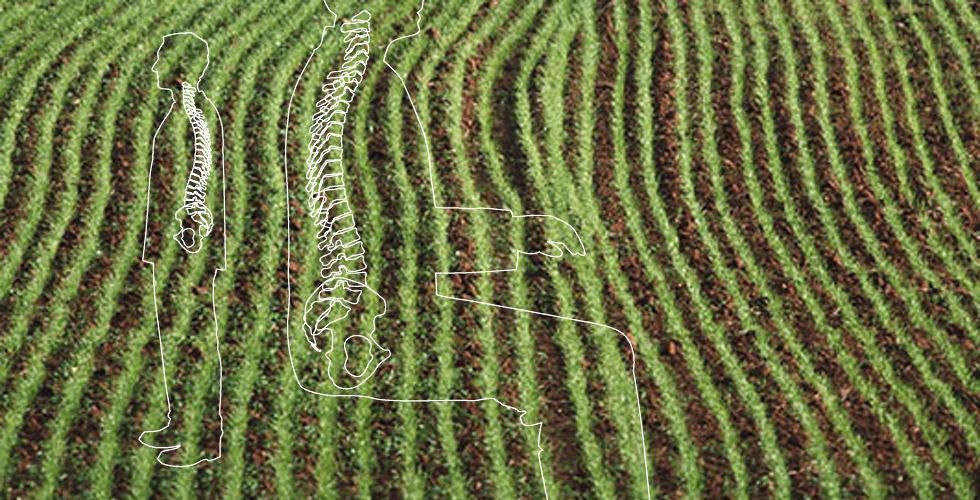Ergonomic Criteria for the Design of the Aeron Chair
A work chair should preserve natural spinal alignment, even in upright postures. Reclining postures help to maintain the natural curve of the spine by opening the angle between torso and thigh to attain pelvic alignment. The same effect can be achieved in upright postures by stabilizing the sacral-pelvic area of the back to sustain the forward pelvic tilt that promotes natural spinal curvatures and muscle balance.
What We Know
People are more likely to sit in upright or forward-leaning postures than to recline while working at the computer.
Lumbar support alone cannot naturally restore spinal curvatures in a body that is seated in an upright position.
The pelvis serves as the body’s center of mass and the primary attachment location for muscles that move the upper and lower body.
When the pelvis rotates in a rearward position, the body works to restore balance at the cost of muscle fatigue and discomfort.
For the purposes of studying the seated human body at work, ergonomists have identified three postures based on the location of the body’s center of mass: reclining, upright, and forward leaning. / See Figure 1 /
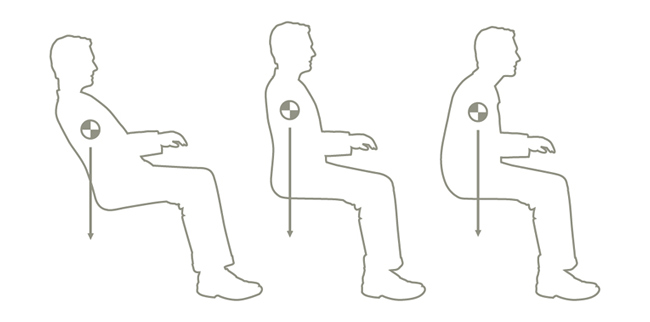
/ Figure 1 / Typical seated postures: reclining, upright, forward leaning
Because the reclined position was often observed to be the preferred posture among people seated at work, even for early users of VDTs and personal computers (Kroemer and Grandjean, 1997), work chair designers have focused their efforts on creating backrests that provide appropriately placed support and tilt mechanisms that maintain that support as the sitter moves through various postures.
However, a recent study of seated behaviors undertaken by researchers at Herman Miller suggests that as a greater percentage of office work tasks are performed on the computer, people are spending a smaller percentage of time in the reclined postures that were traditionally preferred for activities such as telephoning, reading from hard copy, conversation, and even continuous keyboarding. The “Office Seating Behaviors” study found that people performing computer-related tasks used upright or forward-leaning postures nearly 75 percent of the time (Dowell, Green, and Yuan, 2001).
The finding is significant because each of the three postures affects the shape of the lumbar spine, or lower back, differently.
The human spine / See Figure 2 / has four functional parts: the cervical spine (neck), the thoracic spine (trunk), the lumbar spine (lower back), and the sacrum (commonly referred to as the “tailbone”). Because the pelvis is rigidly attached to the sacrum, and the sacrum is fixed to the lumbar spine, any rotation of the pelvis influences the shape of the lumbar spine (Chaffin and Andersson, 1991), and any condition that produces a change in one of the spinal curvatures will cause compensatory changes in the other curves to maintain balance and conserve muscular energy (Rosse and Gaddum-Rosse, 1997).
In addition to being the location of the body’s center of mass, the pelvis serves as the attachment point for 20 major muscle groups that function to initiate movement and to counterbalance gravitational forces in both the upper and lower body (Rosse and Gaddum-Rosse, 1997).

/ Figure 2 / The human spine and pelvis

When a person moves from a standing to a seated position, the pelvis tends to rotate backward, causing the lumbar spine to flatten from its natural lordotic (inwardly curved) shape or even to assume a kyphotic or outward curve / See Figure 3 /, resulting in increased pressure on the intervertabral discs (Andersson, 1974) and increased muscle activity as the body attempts to restore balance (Rosse and Gaddum-Rosse, 1997). This results in increased fatigue and discomfort for the sitter over the course of the workday.
Research has shown that, in reclined postures, adding lumbar support and increasing the angle between the seat and backrest of a chair allows for a natural forward rotation of the pelvis, which reduces disc pressure and muscle activity in the lower back (Andersson and Ortengren, 1974). However, the effect of lumbar support is much reduced when the sitter is in an upright or forward-leaning posture (Andersson, 1974).
/ Figure 3 / The position of the pelvis determines the shape of the lumbar spine.
Therefore
A good work chair will promote natural, unforced, spinal alignment and muscle balance even when the sitter is not in a reclined posture.
Design Problem
Develop back support that comfortably sustains the pelvis in its natural forward tilt in upright postures.
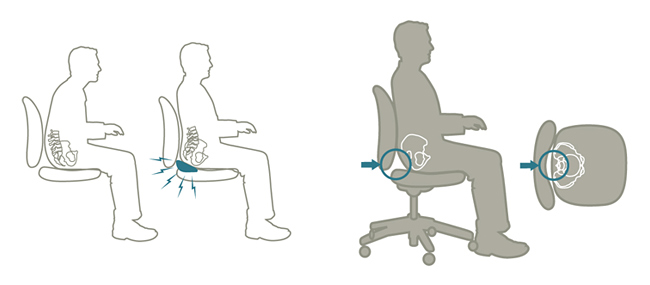
Left: / Figure 4 / Previous research experimented with pelvis support under the seat (Wu et al., 2001).
Right: / Figure 5 / The void: Typical chairs leave the base of the spine unsupported.
For years, experts in design, ergonomics, and medicine have recognized the importance of seating design that controls the rearward tilt of the pelvis. Recent research found that the addition of a wedge-shaped “pelvic support” just behind the ischia / See Figure 4 / stops the rearward rotation of the pelvis in upright postures and prevents the unnatural flattening or kyphotic curving of the lumbar spine. However, experimentation with different degrees of inclination in the wedge supports found that those that could control pelvic rotation (20 to 30 degrees of incline) led to discomfort and soreness when placed on the seat just behind the ischia (Wu et al., 1998).
In addition, one person’s natural lordotic curve differs from another’s, so the amount of pelvic support required to maintain individual spinal alignment varies. If there is not sufficient support, the pelvis will rotate backward and flatten the lumbar spine. If there is too much support, the pelvis may be forced to tilt too far forward, creating extreme lumbar lordosis that causes the thoracic and cervical spine to compensate with extreme curves to maintain balance (Rosse and Gaddum-Rosse, 1997). The result of such a forced posture is increased muscle activity and disc pressure leading to fatigue and discomfort (Andersson, 1974).
Many work chair designs have attempted to control rearward pelvic tilt by lowering the lumbar support to the pelvic level or by providing support for the ilia bones of the pelvis. But these solutions leave a void between the backrest and the sitter’s lower back. / See Figure 5 / This failure to provide evenly distributed support across the entire, contoured surface of the sacral-pelvic region leaves the base of the spine unsupported.
Design Solution
Adjustable, contoured fit and support for the sacral-pelvic region that provides a controlled forward pelvic tilt to restore spinal curvatures and muscle balance comfortably and naturally.
Designed as an optional addition to the Aeron chair, PostureFit seating technology was developed to provide sacral-pelvic support in cooperation with the inter-reliant tissues, structures, and contours of the human body.
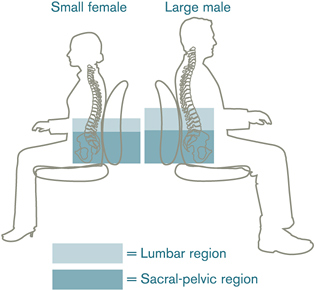
The design is based on the research and expertise of Brock Walker, D.C., a specialist in musculoskeletal disorders who has consulted with the aerospace, automotive, and motor-sports industries on medically engineered seating designs.
Although the location of the lumbar spine varies greatly from person to person—as much as 4 inches or +/- 2 inches (Dowell, 1995)—there is little variation (+/- 5/8 inch) among the adult population in the height and width of the sacral-pelvic anatomy (Reynolds et al., 1982), / See Figure 6 / This allowed Walker to design a single-sized back support, shaped to fit the contours of the sacral-pelvic area, that could be added to the backrest of the Aeron chair.
/ Figure 6 / There is little variation in the height and width of the sacral-pelvic anatomy.
PostureFit adjusts to fill the void between the contours of the sacral-pelvic area and the backrest. This improved contact and support helps to sustain the forward tilt of the pelvis, which restores natural spinal curvatures to improve posture and muscle balance, thereby reducing fatigue and increasing endurance.
By simultaneously supporting the sacrum and the ilia, this approach improves surface load distribution across the lower back to provide comfortable, contoured support. A single adjustment allows sitters to fit the device to their individual anatomical contours, regulating the load pressure distribution between the sacral-pelvic region and the chair’s Pellicle suspension. / See Figure 7 /

/ Figure 7 / It is shaped to provide load distribution across the lower back and to deliver comfortable, contoured support.
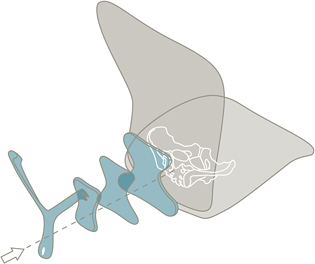
Codesigners of the Aeron chair, Stumpf Weber + Associates worked with Walker to shape the support’s contours to fit the human torso as well as the shapes and contours of the chair’s backrest design.
Prototypes of the technology were reviewed at different points of development by ergonomics experts to validate the effectiveness of the concept, and a series of laboratory tests was conducted to measure the effect of the PostureFit support on pelvic rotation and lumbar flexion.
/ Figure 8 / PostureFit supports the base of the spine.
A coordinate-measurement machine was used to locate and measure the distance between 15 body landmarks in test subjects sitting in chairs equipped with PostureFit technology. Individual measurements taken from a single test subject have shown that a fully engaged PostureFit device holds the pelvis at an angle 7.2 degrees forward of its location in a chair without PostureFit or lumbar support and 4.2 degrees forward of its location in a chair equipped with lumbar support alone.
Lumbar flexion, a dimension that measures lumbar lordosis, was shown to improve 5.5 degrees when the subject sat in the PostureFit-equipped chair compared to the chair with lumbar support. Matthew Reed, Ph.D., an ergonomics expert from the University of Michigan, examined the data from this study. “Controlling pelvis rotation is the key to controlling lumbar spine flexion,” he writes. “Although the postural effects of a lumbar or pelvic support vary among individuals, even small reductions in lumbar spine flexion may be important for comfort and health” (Reed, 2002).
To determine if improved pelvic stabilization actually contributes to improved comfort, Herman Miller researchers conducted two extensive use tests with the PostureFit device. In the first study, 87 people who regularly worked in Aeron chairs with adjustable lumbar support used Aeron chairs equipped with PostureFit for two days. Test subjects rated the PostureFitequipped chair higher than the chairs with adjustable lumbar support on providing lower back support. Users also reported maintaining a more healthful posture while sitting in the PostureFit-equipped chair (Herman Miller Product Research Group, 2002).
A second study, involving 52 users sitting in PostureFit-equipped Aeron chairs for one month, confirmed the results of the first study. The PostureFit chair was rated significantly higher than the lumbar support chair for lower back support and healthful posture. In both tests, when asked directly which chair they preferred, over 80 percent of the participants chose the PostureFit-equipped chair (Herman Miller Product Research Group, 2002).
References
Andersson (1974), “On Myoelectric Back Muscle Activity and Lumbar Disc Pressure in Sitting Postures,” doctoral dissertation.
Andersson and Ortengren (1974), “Lumbar Disc Pressure and Myoelecctric Back Muscle Activity During Sitting,” Scandinavian Journal of Rehabilitative Medicine.
Chaffin and Andersson (1991), Occupational Biomechanics.
Dowell (1995), “An Estimation of Lumbar Height and Depth for the Design of Seating,” Proceedings of the Human Factors and Ergonomic Society 39th Annual Meeting.
Dowell, Green, and Yuan (2001), “Office Seating Behaviors: An Investigation of Posture, Task, and Job Type,” Proceedings of the Human Factors and Ergonomics Society 45th Annual Meeting.
Herman Miller Product Research Group (2002), “Aspen User Research Project Report,” internal report.
Kroemer and Grandjean (1997), Fitting the Task to the Human, Fifth Edition.
Reed (2002), “Comparison of the Postural Effects of PostureFit and Lumbar Support,” internal report.
Reynolds et al. (1982), Spatial Geometry of the Human Pelvis, Memorandum Report Acc-119-81-5, Federal Aviation Administration, Civil Aeromedical Institute.
Rosse and Gaddum-Rosse (1997), Hollinshead’s Textbook of Anatomy, Fifth Edition.
Wu et al. (1998), “Research on Pelvic Angle Variation when using a Pelvic Support,” Ergonomics.
Credits
Bill Dowell was Herman Miller’s board-certified Corporate Ergonomist at the time of his death in 2012. During his 28-year career at Herman Miller, Bill was instrumental in leading research into the study of ergonomics and applying the principles of good ergonomic design to our products. In 1991, Bill played a pivotal role in Herman Miller becoming a charter member of the Office Ergonomic Research Committee (OERC). Bill was a key member of the BIFMA Ergonomics Subcommittee that was responsible for the original BIFMA Ergonomic Guideline for VDT Furniture, and was also a member of the committee that revised the BSR/HFES 100 Standard for Human Factors Engineering of Computer Workstations. He was also a member of the CAESAR 3-D surface anthropometric survey and the Human Factors and Ergonomics Society, representing Herman Miller in both groups. Bill’s published work includes studies of seating behaviors, seated anthropometry, the effect of computing on seated posture, the components of subjective comfort, and methods for pressure mapping.
The late Bill Stumpf studied behavioral and physiological aspects of sitting at work for more than 30 years. A specialist in the design of ergonomic seating, his designs include the Ergon chair, introduced by Herman Miller in 1976 and, with Don Chadwick, the equally innovative Equa and Aeron chairs. He contributed significantly to the design of the Embody chair prior to his death in 2006. In that same year, he posthumously received the National Design Award in Product Design presented by the Smithsonian’s Cooper-Hewitt, National Design Museum.
Brock M. Walker, D.C., specializes in musculoskeletal disorders and medically engineered design. He has consulted with Fortune 100 companies, the U.S. and foreign militaries, and the marine, aerospace, entertainment, and motor-sport industries to enhance seating environments for home, workplace, transportation, and healthcare facilities. He holds a number of patents in the fields of biomechanics and ergonomics.
